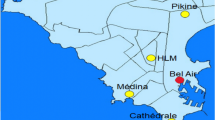Abstract
A situation-dependent intensity prediction (SDIP) technique is developed for western North Pacific tropical cyclones that is based on the average of the intensity changes from the 10 best historical track analogs to the Joint Typhoon Warning Center best-tracks. The selection of the 10 best track analogs is also conditioned on the current intensity, and it is demonstrated that for a subsample of current intensities less than or equal to 35 kt the intensity mean absolute errors (MAEs) and biases are smaller than for the greater than 35 kt intensity subsample. The SDIP is demonstrated to have advantages as an intensity skill measure at forecast intervals beyond 36 h compared to the current climatology and persistence technique that uses only variables available at the initial time. The SDIP has significantly smaller intensity MAEs beyond 36 h with an almost 20% reduction at 120 h, has significantly smaller intensity biases than the present skill metric beyond 12 h, and explains 36% of the intensity variability at 120 h compared to 20% explained variance for the current technique. The probability distributions of intensities at 72 h and 120 h predicted by the SDIP are also a better match of the distribution of the verifying observations. Intensity spread guidance each 12 h to 120 h is developed from the intensity spread among the 10 best historical track analogs. The intensity spread is calibrated to ensure that the SDIP forecasts will have a probability of detection (PoD) of at least 68.26%. While this calibrated intensity spread is specifically for the SDIP technique, it would provide a first-order spread guidance for the PoD for the official intensity forecast, which would be useful intensity uncertainty information for forecasters and decision-makers.
Similar content being viewed by others
References
Chu, J.-H., 1994: A regression model for western North Pacific tropical cyclone intensity forecasts. NRL Memo. Rep. 7541-94-7215, Naval Research Laboratory, 33 pp [available from Naval Research Laboratory, 7 Grace Hopper Avenue, Monterey, CA 93943].
DeMaria, M., J. A. Knaff, and C. R. Sampson, 2007: Evaluation of longterm trend in tropical cyclone intensity forecasts. Meteor. Atmos. Phys., 97, 19–28.
____, C. R. Sampson, J. A. Knaff, and K. D. Musgrave, 2013: Is tropical cyclone intensity guidance improving? Bull. Amer. Meteor. Soc., early on-line release, doi: 10.1175/BAMS-D-12-00240.1
____, M. Mainelli, L. K. Shay, J. A. Knaff, and J. Kaplan, 2005: Further improvement to the Statistical Hurricane Intensity Prediction Scheme (SHIPS). Wea. Forecasting, 20, 531–543.
Elsberry, R. L., 2007: Advances in tropical cyclone motion prediction and recommendations for the future. Bull. World Meteor. Organiz., 56, 131–135.
____, M. S. Jordan, and F. Vitart, 2010: Predictability of tropical cyclone events on intraseasonal timescales with the ECMWF monthly forecast model. Asia-Pac. J. Atmos. Sci., 46, 135–153.
____, _____, and _____, 2011: Evaluation of the ECMWF 32-day ensemble predictions during 2009 season of western North Pacific tropical cyclone events on intraseasonal timescales. Asia-Pac. J. Atmos. Sci., 47, 305–318.
Fraedrich, K., C. C. Raible, and F. Sielmann, 2003: Analog ensemble forecasts of tropical cyclone tracks in the Australian region. Wea. Forecasting, 18, 3–11.
Goni, G., and Coauthors, 2009: Applications of satellite-derived ocean measurements to tropical cyclone intensity forecasting. Oceanography, 22, 190–197.
Knaff, J. A., C. R. Sampson, and M. DeMaria, 2005: An operational statistical typhoon intensity prediction scheme for the western North Pacific. Wea. Forecasting, 20, 688–699.
____, M. DeMaria, C. R. Sampson, and J. M. Gross, 2003: Statistical, five-day tropical cyclone intensity forecasts derived from climatology and persistence. Wea. Forecasting, 18, 80–92.
Maidment, D. R., 1993: Wilcoxon signed-rank test. Handbook of Meteorology. McGraw-Hill, 142 pp.
Sampson, C. R., J. L. Franklin, J. A. Knaff, and M. DeMaria, 2008: Experiments with a simple tropical cyclone intensity consensus. Wea. Forecasting, 23, 304–312.
____, R. J. Miller, R. A. Kreitner, and T. L. Tsui, 1990: Tropical cyclone track objective aids for the microcomputer: PCLM, XTRP, PCHP. Naval Oceanographic and Atmospheric Laboratory, Tech Note 61, 15 pp. [available from Naval Research Laboratory, 7 Grace Hopper Avenue, Monterey, CA 93943]
Sievers, O., K. Fraedrich, and C. C. Raible, 2000: Self-adapting analog ensemble predictions of tropical cyclone tracks. Wea. Forecasting, 15, 623–629.
Tsai, H.-C., and Y. L. Chen, 2010: Utilizing the track analog and the reanalysis data to support typhoon climatological rainfall forecasts. Presentation, Conference on Weather Analysis and Forecasting, Taiwan Central Weather Bureau, Taipei, Taiwan.
____, R. L. Elsberry, M. S. Jordan, and F. Vitart, 2013: Objective verifications and false alarm analyses of western North Pacific tropical cyclone event forecasts by the ECMWF 32-day ensemble. Asia-Pac. J. Atmos. Sci., 49, 409–420.
Author information
Authors and Affiliations
Corresponding author
Rights and permissions
About this article
Cite this article
Elsberry, R.L., Tsai, HC. Situation-dependent intensity skill metric and intensity spread guidance for western North Pacific tropical cyclones. Asia-Pacific J Atmos Sci 50, 297–306 (2014). https://doi.org/10.1007/s13143-014-0018-5
Received:
Accepted:
Published:
Issue Date:
DOI: https://doi.org/10.1007/s13143-014-0018-5




